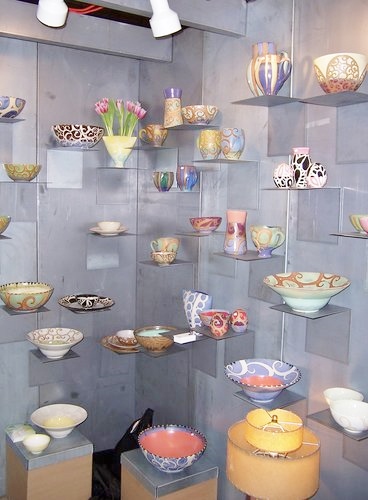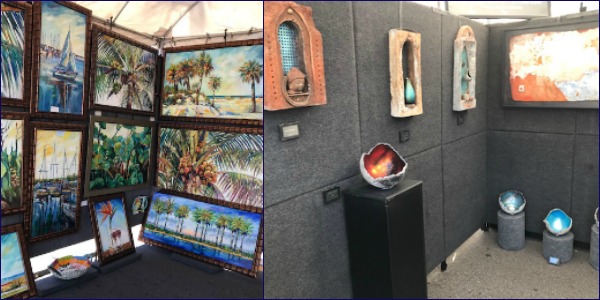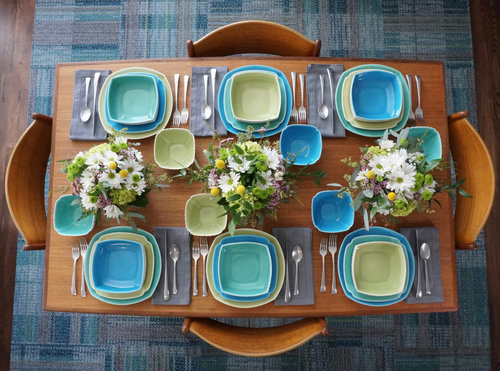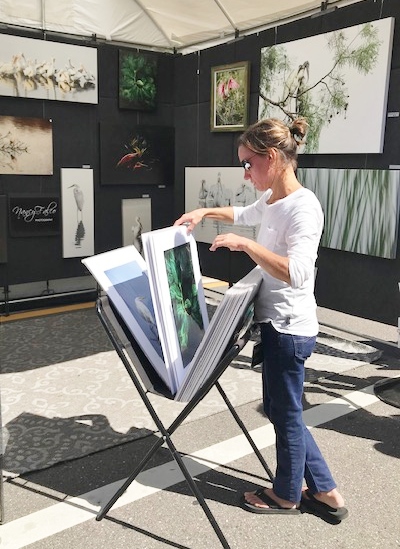by Carolyn Edlund
Design your display as the perfect space to show your art using these merchandising tips.

Items are individually displayed in this well-lit booth featuring ceramic work by artist Liz Kinder.
Whether you’re setting up a booth at a fair, planning a pop-up, or a designing a sales area in your studio, your space should be carefully planned to show your work to its best advantage while providing a great customer experience.
Focus on Lighting
Good lighting is a key essential to an effective display. A bright and welcoming booth attracts shoppers, while darkened spaces turn them off. LED lights are most suitable. They don’t throw heat, which prevents your booth from becoming uncomfortable. LEDs are long-lasting, energy efficient and work perfectly as track lighting. And, they emit light in a specific direction, which reduces the need for reflectors and diffusers. Strategically placed LED lighting will highlight particular items of interest in your display and can be used for dramatic effect.
Avoid Clutter
A display jammed with merchandise instantly gives the impression that you are selling commodity items, and lowers the perceived value of your work overall. Instead, allow breathing room for each piece in your display. Galleries do this very effectively by hanging works far enough apart to invite individual attention and consideration. “Less is More” is a good mindset when planning your display. Pull out fresh inventory and restock as your art sells.

Left, a tightly crowded booth shows a jumble of items that fight with each other for attention. Right, wise use of space gives a “gallery” look that presents more professionally.
Place Product at Eye Level
Retailers know that eye level is the “sweet spot” for product placement and produces the highest revenues. Use this technique to put your bestsellers literally in front of your customers’ eyes and increase your sales. When shoppers must bend over or stretch to see merchandise, they can be frustrated. Make it convenient to see your work, and easy to buy.

Artist Dara Hartman’s table setting display encourages collecting.
Use Product Groupings
Create displays that feature sets and groupings that work together beautifully or make big impact. Is your work collectible? A well-planned display of a grouping can enhance the shopping experience (see Dara Hartman’s entire table setting above.) Use these visuals in both your display and in photography to entice your audience to recreate the look for themselves by making a multiple purchase, or collect over time.
Attract with a Showpiece
An anchor piece in a display can make big impact and draw attention. The showpiece may be a large, ornate or high-end example of your work. It’s purpose is to be the hook that generates buzz, but often showpieces won’t be sold. The majority of purchases will be smaller, lesser expensive items displayed near or around the showpiece that echo the look, but fit the pocketbook of most customers.
Lead the Eye
A booth that includes merchandise at different levels adds interest and steers attention throughout the display. Use groupings in odd numbers to keep the eye moving. Items displayed on pedestals at different heights, or in a pyramid design are appropriate complements to art hung on the walls. Signage can also be placed to pull attention to various areas of your display.

Move items for sale forward in your display, making them touchable, accessible and easy to shop.
Encourage Touching
Feed the senses to start audience engagement. Touch is an incredibly important part of shopping. It’s been said that placing an item in the customer means that it is “three quarters sold.” Unless you are selling very small, fragile or high-end items, place your inventory out front in a display that invites customers to touch and hold your work.
A great display can break the ice, inviting potential collectors in to learn more about you and your art. Your role as the artist is to make the visitor welcome, encourage conversation, gather information and share your story. The display that you present as a visual introduction tells customers that you have something exceptional to offer.



[…] these spaces offer an immediate audience that’s often eager to discover new talent. Preparing a visually appealing display and having a direct engagement strategy can turn these local opportunities into significant […]